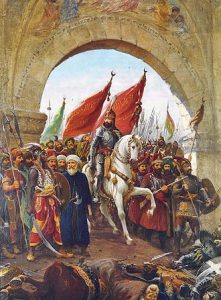-
-
The environmental reason
The climate changes influence the decline of the silk road. The zone of the Silk Road itself, this broad belt of oasis-punctuated deserts extends across Central Asia from northwestern China to the Caspian and Black Seas, and on to the Middle East. The zone is bounded on the north and south by mountains. Features including a high, dry terrain, infrequent and irregular water supplies, absent or scarce forage for caravan animals.(Major). During Han dynasty, there were still have many oases in the silk road, however, the climate of east Asia got colder and the precipitation decreased, the rivers on the land silk road began to break down and the desertification continued to expand. This situation leads the silk road lost freshwater and vegetation. Lots of areas became infertile. Also, during the period of the yuan and Ming dynasties, immigration policies were carried out, people cut down trees to plant crops, the result is the wind and sand continued, all the farmland turned into sand. The bad climate and horrible environment stop the steps of merchants.

Also, the cultures around the silk road were disappeared by the climate changes. For example, the Loulan Kingdom. The ruins of Loulan are near the now-desiccated Lop Nur in Xinjiang, and they are now completely surrounded by desert. (Mallory and Mair (2000). pp. 81-87)
(The relics of Loulan, Baidu)
-
- Because of these countries’ disappearance, less and fewer trade caravans went to make the exchange by the silk road.
-
2.The Tang dynasty lost the control power of the Western regions
Tang was in the Wars. The most serious one called “An Lushan Rebellion”.
The An Lushan Rebellion was a devastating rebellion against the Tang dynasty, because of the rebellion began on December 755, and ended in February 763. During the rebellion, An Lushan established a dynasty called Yan. He declared that he was the emperor of Northern China. The Yan dynasty’s territory included Hebei, Arab, Uyghur, and Sogdian. He controls many of Chinese national minority forces to against the Tang. Because of this catastrophic rebellion, Tang lost the Western Regions.
In 763 AD, Tibetan Empire attacked and occupied Changan, which is the capital of Tang dynasty. Also, Tibetan Empire controls the Hexi Circuit and Longyou regions. In 808 AD, the Tang dynasty lost four garrisons of Anxi, which were the most important place of control the Western Regions. The exchange between China and Western Countries was cut off by Tibetan Empire’s control.
3. Maritime Silk Road.
The Ottoman empire consolidated control over the eastern Mediterranean, closing off key overland trade routes. Their dominance in the Middle East and North Africa forced Europeans to search for other trade. (The Ottoman Empire Army)
(The Ottoman Empire Army)
At the same time, the economics of Southern China were getting better than Northern China. Chinese people had the more advanced technology of shipbuilding, also the skills of navigation had big improvement at that time. Because of these factors, people who lived in coastal China made the trade with other countries were easier than before. The Ming Dynasty sent Zhenghe and his ships team to voyage 7 times. He expanded the trade road on the sea.
Quanzhou has become the biggest trade port in the World. The Maritime Silk Road is more convenient, so it replaced the position of the traditional Silk Road.


 (An lushan)
(An lushan)
